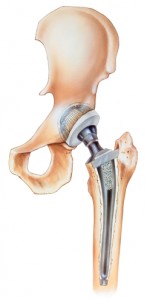 Our orthopedic surgeons Dr. Watt, Dr. Peterson, and Dr. Downer, now perform total hip replacement and other hip surgeries through a smaller, less-invasive approach. The purpose of the anterior approach is to perform a total hip replacement with less disruption of the surrounding soft-tissues and muscles. When the doctor performs this procedure through smaller incisions, there is less pain and a faster recovery because there is less soft-tissue and muscle dissection.
Our orthopedic surgeons Dr. Watt, Dr. Peterson, and Dr. Downer, now perform total hip replacement and other hip surgeries through a smaller, less-invasive approach. The purpose of the anterior approach is to perform a total hip replacement with less disruption of the surrounding soft-tissues and muscles. When the doctor performs this procedure through smaller incisions, there is less pain and a faster recovery because there is less soft-tissue and muscle dissection.
Anterior hip surgery is not a new idea; in fact, many surgeons have chosen this approach since the 1980s. However, what is new about the anterior hip replacement procedure is the surgeons are using smaller incisions and more specialized instruments to make the surgery less traumatic to the patient.
Regardless of the type of incision, all hip replacements require your orthopedic specialist to replace the top of the thigh bone (the femur) and the pelvis socket. The hip joint is deep within the body at the junction of the femur and pelvis. The main goal with these procedures, regardless of where the incision is made, is that they replace the ball and socket of this joint.
What are some Unique Aspects of Anterior Approach Hip Replacement?
To help limit post-surgical soreness and irritation, the minimally invasive anterior approach uses a small incision. The anterior approach to hip replacement is a muscle-splitting approach, also. This means that the orthopedic specialist gets to the hip between two muscles, rather than by removing and then reattaching the muscle tissue. The advantage is thought to be that recovery can proceed quicker because there is no reattached muscle that needs to heal. Another advantage of the anterior approach is that there tends to be a lower rate of dislocation. Most complications, however, are similar to those complications of standard hip replacement.
Is Anterior Hip Replacement Better than Traditional Surgery?
Our orthopedic specialists feel that the anterior hip replacement option is an improvement over other approaches for surgery because of the increased recovery time. The goal of surgery is to give you a joint that is pain-free and will last you a long time, allow you to recover in a shorter period of time, and to get you back to your activities of daily living.
What are the Common Causes of Hip Pain?
The most common reason for an anterior hip replacement is from the pain and disability brought on by arthritis. Osteoarthritis, or “OA”, is the age-related “wear-and-tear” type of the disease. It is more common in people over age fifty and those with a family history of arthritis. The cartilage cushioning the bones of the hip wears away and the bones then start to rub against each other. This leads to significant stiffness and hip pain.
A worse form of arthritis is rheumatoid arthritis or RA. RA is an autoimmune disease where the synovial membrane becomes thick and inflamed. The constant chronic inflammation of RA causes damage to the cartilage and this leads to stiffness and pain. Post-traumatic arthritis can follow a serious hip fracture or other injury. With this type, the cartilage becomes damaged from the trauma and pain and stiffness sets in.
Another cause of hip pain is avascular necrosis. This is an injury to the hip that limits the blood supply to the top portion of the thigh bone (the femur). This could be from a dislocation or fracture. When the bone is deprived of blood, the surface could collapse and arthritis develops.
What Should I Do Before the Surgery?
Several adjustments can make your house easier to navigate during your recovery. The following tips may help with daily activities:
- Install securely fastened safety bars or handrails in your shower or bath
- Secure handrails along all stairways
- Purchase a stable chair for your early recovery with a firm seat cushion, a firm back, and two arm rests
- Use a raised toilet seat
- Purchase a stable shower bench or chair for bathing
- Use a long-handled sponge and shower hose
- Get dressing stick, sock aid, and long-handled shoe horn for putting on and taking off shoes and socks
- Purchase a “reacher” that will allow you to grab objects without excessive bending of your hips
- Use firm pillows for your chairs, sofas, and car that allow you to sit with your knees below your hips
- Remove of all loose carpets, throw rugs, and electrical cords from the areas where you walk
What are the Pros and Cons of the Anterior Hip Replacement Approach?
The anterior approach has many benefits. Some of these include:
- Accelerated rehabilitation time because key muscles do not have to be detached during the procedure
- Fewer restrictions during recovery because the patient can more freely bend the hip and bear weight
- Reduced scaring because the technique uses one relatively small incision
- More stable implant sooner after the surgery because muscle and tissue do not have to be disturbed
As with other types of surgery, the anterior approach has some risks. These include:
- Infection – may occur superficially in the wound or deep inside around the prosthesis
- Blood Clot – may occur in the leg veins or pelvic region; can be life-threatening
- Leg-Length Inequality – occurs when one leg feels longer than the other
- Dislocation – occurs when the ball comes out of the socket
Find OSS on Facebook and follow on Twitter to keep up to date on new articles and news.
